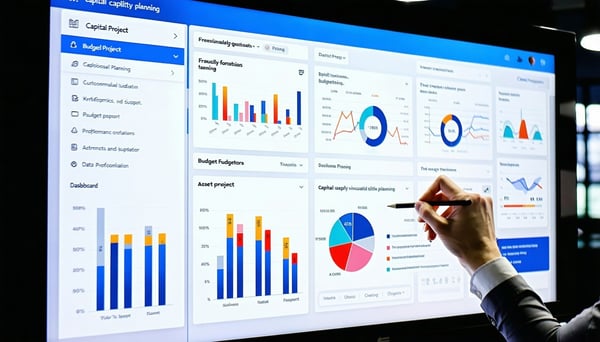Every building tells a story. The question is—do you know what yours is saying? A Facility Condition Assessment (FCA) is a tool that helps building owners, asset managers, and capital planners read that story clearly.
At Intellis Labs, we believe an FCA isn't just a checklist—it's a roadmap to smarter decisions, safer facilities, and more substantial investments.
The MBCx Firm's Guide to Facility Condition Assessments
In this guide, we'll walk through what FCAs are, why they matter, when you need them, and how they work. By the end, you'll know exactly how an FCA can help you make better choices about your facilities.
Schedule a quick discovery call to find out more!
What Is a Facility Condition Assessment, Really?
At its core, a Facility Condition Assessment is a structured look at the health of your building and its systems—roof, HVAC, electrical, plumbing, finishes, and more.
 Think of it like a physical exam for your building. It reveals what's working, what's wearing out, and what needs attention now to avoid bigger costs later.
Think of it like a physical exam for your building. It reveals what's working, what's wearing out, and what needs attention now to avoid bigger costs later.
FCAs aren't just about finding problems—they're about providing the data you need to plan, budget, and prioritize with confidence.
Why FCAs Are Worth Your Time
The short answer? They save money, reduce risk, and support better decision-making.
An FCA gives you:
-
Budget clarity – No more guessing when a chiller will fail or how much that roof replacement will cost.
-
Risk reduction – Identify and address issues before they escalate into emergencies.
-
Compliance assurance – Stay ahead of code requirements and regulations.
-
Funding justification – Show stakeholders the real, data-backed needs of your facilities.
For example, implementing software for FCAs can help a university campus discover that a $1.2M roof replacement could be postponed by five years with the right maintenance plan—something they'd never have seen without using software to extract and analyze data from their FCA.
When Should You Conduct One?
The truth is, there's no one-size-fits-all schedule. But there are key moments when an FCA makes the most impact:
-
Before major renovations or expansions
-
During capital planning or budget cycles
-
Before buying or selling a property
-
When compliance questions arise
-
For aging facilities that haven't been reviewed in years
In other words, if you're about to make big decisions about your buildings, that's the time to get fresh data.
How an FCA Actually Works (Step by Step)
No clipboards full of jargon—just a straightforward process that starts with walking the site and ends with a report you can actually use.
Here's how it works:
-
Define scope and goals – What do you need to know? What's most important to your operations?
-
Site visit & visual inspection – The inspection team walks the property, evaluating it system by system.
-
Data collection – Document assets, equipment, and conditions.
-
Condition ratings – Each element is scored to show its relative health.
-
Cost estimating – Repair vs. replace, immediate vs. deferred.
-
Reporting & recommendations – Clear takeaways, not just a data dump.
The result: you know which repairs matter most, what they'll cost, and when to plan for them.
Schedule a discovery call to learn more.
Tools & Tech That Power FCAs
Gone are the days of 200-page binders gathering dust. Today's assessments use technology that makes the data actionable.

-
Facility Condition Index (FCI) helps compare the health of different buildings.
-
Dashboards & digital reports let you slice, sort, and plan in minutes.
-
Mobile data collection ensures accuracy right from the field.
We believe the best FCA is the one you can actually use—not one that gets buried in a filing cabinet.
What You Get Out of It
An FCA isn't just a binder—it's a blueprint. Deliverables typically include:
-
A complete inventory of facility systems and components
-
Condition ratings for each
-
Cost estimates for repairs and replacements
-
Prioritized recommendations (immediate, mid-term, long-term)
-
Strategic insights for capital planning
This information helps you plan maintenance, justify budgets, and communicate clearly with stakeholders.
Best Practices to Get the Most Value
To maximize the impact of an FCA:
-
Prepare your site team – Make sure access is easy and safe.
-
Gather your documentation – Prior inspection reports, maintenance logs, and as-builts.
-
Use the results as a springboard – An FCA isn't a one-and-done; it's the first step in a smarter, ongoing planning cycle.
Think of it as the beginning of a long-term conversation with your buildings.
How the FOUNDATION Platform Brings Your FCA to Life
A Facility Condition Assessment is only as valuable as what you do with the results. That's where FOUNDATION, our capital planning platform, comes in.
 Instead of leaving your FCA in a static PDF, FOUNDATION turns your assessment data into a dynamic, living plan you can actually work with. Here's how it helps:
Instead of leaving your FCA in a static PDF, FOUNDATION turns your assessment data into a dynamic, living plan you can actually work with. Here's how it helps:
-
Centralized Data – All your facility condition data, reports, and cost estimates live in one secure platform.
-
Scenario Planning – Model different capital plan options and see how today's decisions impact tomorrow's budget.
-
Prioritization Tools – Sort projects by urgency, cost, compliance, or risk, so you always know where to act first.
-
Collaboration-Friendly – Share updates with stakeholders, boards, or finance teams in real time.
-
Ongoing Updates – Keep your FCA data fresh as new inspections or repairs are completed.
With FOUNDATION, your FCA becomes more than a snapshot—it becomes a strategic roadmap for managing deferred maintenance, justifying funding, and aligning facility needs with organizational goals.
Schedule a demo to experience our software firsthand.

Let's Talk About Your Buildings
If you're thinking it might be time for a Facility Condition Assessment, let's talk. Our team has walked hundreds of sites, from schools to government campuses to office portfolios.
We'd be happy to help you figure out the right next step—whether that's a full FCA, a targeted assessment, or just a conversation about where to begin.
FAQs
How long does an FCA take?
It depends on facility size and scope, but typically anywhere from a few days to a few weeks.
How much does it cost?
Costs vary based on square footage, complexity, and the depth of analysis. The investment usually pays for itself through avoided surprises and smarter capital planning.
Do assessments disrupt operations?
Minimal disruption. Most inspections are visual and non-invasive.
How often should they be repeated?
Every 3–5 years is common, but high-use facilities may benefit from more frequent reviews.
Resources & Further Reading
Want to dig deeper? Here are a few helpful resources:
- Checklist: Preparing for a Facility Condition Assessment
- Guide: How FCAs Support Capital Planning
- Article: The Role of FCAs in Deferred Maintenance Reduction
Intellis Labs develops innovative software to help organizations manage, assess, and plan for their facilities. Our Foundation System streamlines facility condition assessments and capital planning, enabling data-driven decisions that optimize budgets, extend the life of assets, and support long-term strategy across education, healthcare, government, and other industries.


